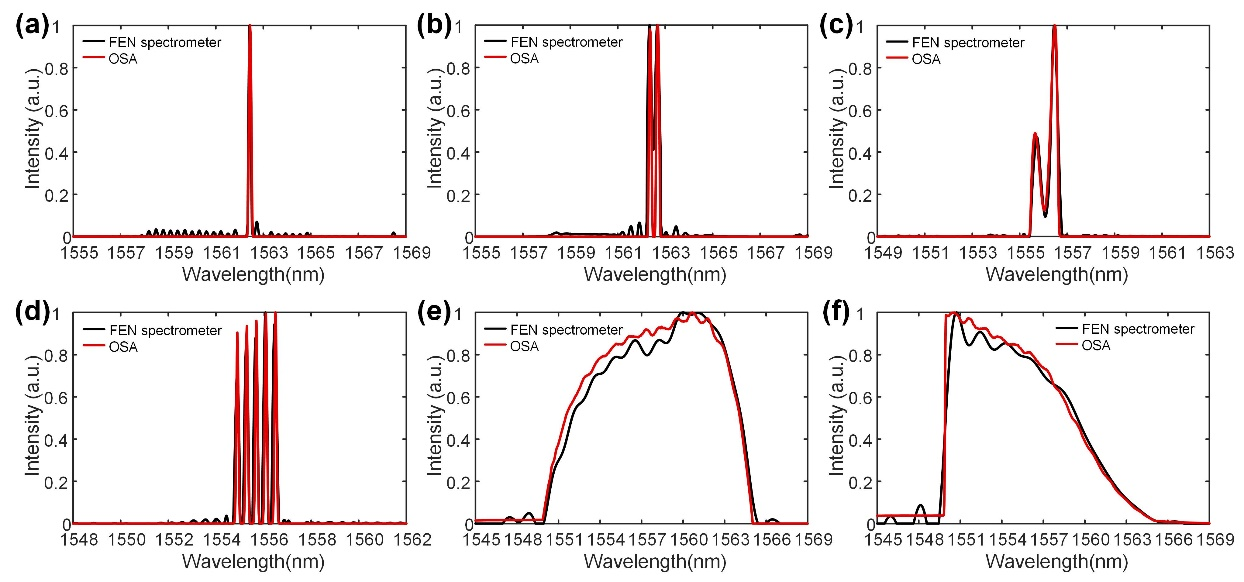Optical spectrum analysis has been reckoned as a notable methodin science studies. Bulky systems utilized forconventional spectrum analyzers give access to high resolution and broad bandwidth, but they may hit a bottleneck in view of their physical dimensions, power consumption, and expensive components. Miniaturized spectrometers required in critical and integrated applications have attracted more and more attention.
Reported dispersive-optics spectrometers and Fourier transform (FT) planar spectrometers rely on long optical path length or large maximum optical path length difference to improve the resolution. Thus, microspectrometers of those categories may bring about a deterioration in performance when miniaturized. Nowadays, reconstructive spectrometers have received great attention. Detectors with distinct and well-tailored transmissions sample the incident signal, and the solution of a linear equation system involving pre-calibrated information is optimized to be the reconstructed spectrum. It has been pointed out that the similarity and smoothness in an individual filter’s spectrum are the main restrictions of spectral resolution. In addition, the pre-read responses are usually inseparable, which thus blocks the scalability of bandwidth.
Recently, Professor Jianji Dong from Wuhan National Laboratory for Optoelectronics of Huazhong University of Science and Technology proposed and demonstrated cascaded nanobeam spectrometer with high resolution and scalability on Optica.
Figure 1 shows the schematic of the cascaded three-channel Fano-enhanced nanobeam (FEN) spectrometer, whose basic unit is FEN resonant cavity. The input light is guided and coupled into the photoniccrystal nanobeam cavities (PCNCs) structure and repeatedly reflected by the one-dimensional etched holes in both ends, and the non-resonant light is regarded as the through-put and transmitted to the next unit. The finely designed parameters of each PCNC unit ensure unique resonant wavelengths individually, which are 1547.44 nm, 1552.80 nm, and 1558.21 nm. To guarantee the coverage of operation bandwidth, active tuning is introduced and thermal electrodes [purple bars in Fig. 1(a)] are configured on the cladding for each FEN unit. The transmission spectra of the three ports in different tuning states are pre-detected and the output powers of incident signal in all tuning states construct a linear equation set. By obtaining a good estimate solution of the equations, the unknown incident signal can be reconstructed.

Figure 1. Overview of the cascaded nanobeam spectrometer.
For a single peak containing narrowband components in Fig. 2(a), the demonstration realizes the reconstruction of 0.16 nm linewidth. To characterize the resolution, a dual peak in Fig. 2(b) with a distance of 0.32 nm is input and retrieved. The proposal has also reconstructed an asymmetric dual peak, multi-peaks, and two broadband signals, as shown in Figs. 2(c)–4(f). Owing to the good orthogonality of the transmission spectra of nanobeam cavities, the system exhibits high resolution, scalable bandwidth and compact size. As a band-engineered structure, this proposal has the potential to be generally transplanted to other operating bands or fabrication platforms and is an ideal candidate for miniaturized spectrometer applications in integrated and portable systems.

Figure 2. Reconstruction results.
Relevant research results were recently published in Optica. The work was supported by the National Natural Science Foundation of China and the Innovation Project of Optics Valley Laboratory.
Full text can be viewed by:https://doi.org/10.1364/OPTICA.453483